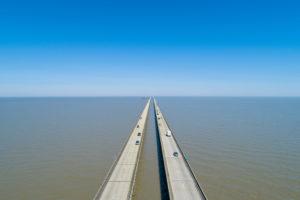
The Lake Pontchartrain causeway bridge is the second-longest bridge over water in the world. It spans 24 miles across the lake from Metairie to Mandeville on the Northshore. An estimated 12 million vehicles use the bridge annually, and unfortunately, not all of them make it across safely.
The causeway is an especially dangerous stretch of road. Since 1994, 18 vehicles have gone over the rails and crashed into Lake Pontchartrain. Utilizing these safety tips could prevent you from experiencing an accident and becoming another causeway statistic.
How Long does It Take to Drive Across Lake Pontchartrain Causeway?
The Lake Pontchartrain causeway bridge is unusually long. The Guinness Book of World Records recognized it as the longest bridge over water. It held this record until 2011 when China completed the Jiaozhou Bay Bridge.
Traveling the causeway can take 25 minutes on a good day. Rain or fog will make this trip take longer. When visibility is poor, traffic will be restricted to one lane in each direction with a speed limit of 35mph. The drivetime on a foggy day could take as long as 45 minutes.
Bear in mind that the bridge has a bascule drawbridge at the 16-mile marker. This allows the passage of boats. Raising the drawbridge requires traffic to come to a full stop and may increase your travel time.
For a free legal consultation, call 800-537-8185
Is the Lake Pontchartrain Causeway Bridge Safe?
Roughly 12 million vehicles cross the causeway every year. However, this crossing is hardly a routine drive.
In 2015 there were 2,000 breakdowns and 178 traffic accidents on the Lake Pontchartrain causeway bridge. Neither side of the causeway has a shoulder, so 65 accidents involved disabled vehicles being rear-ended within two minutes of a breakdown.
Traffic accidents aren’t the only concern. The middle 8-mile section of the bridge can present a frightening scene for motorists. Land is completely out of view. On more than one occasion, police have rescued terrified drivers who stopped on the bridge and could not finish crossing on their own.
What Can You Do to Avoid Becoming a Causeway Statistic?
Despite recent construction that installed railings, safety remains a concern in 2021. Luckily, you can arm yourself with knowledge and prepare to cross the bridge safely.
Keep Your Eyes on the Road
The causeway has no shoulder for disabled vehicles to pull over. You must remain attentive. Watch for stalled vehicles ahead of you.
Proceed With Caution
Don’t tailgate or go over the speed limit. Causeway traffic fines are steep for speeding and tailgating, and perhaps rightly so. These irresponsible actions endanger people and claim motorists’ lives every year.
Avoid Distractions
You should never text and drive. In fact, distracted driving is a leading cause of car accidents on normal roadways.
Be ready to put your phone down and stop fiddling with your dashboard controls. Adjust your radio, AC/heat, and other settings before you enter the bridge.
Avoid the Causeway if Your Car Has Problems
This is not the place for your car to break down. If you drive an older car, anticipate mechanical problems, or have any unaddressed recalls, avoid taking the causeway. Before you enter the bridge, do a quick multi-point vehicle inspection. Check your:
- Defroster
- Windshield wipers
- Headlights
- Taillights
Delay your travel plans until your car is fully functional or arrange to borrow a vehicle to safely travel over the Lake Pontchartrain causeway bridge.
Get to a Crossover If You Experience Trouble
There are seven crossovers on each span of the causeway, spaced approximately 3.5 miles apart. If you can pull your vehicle into the crossover, you’ll be safely out of the flow of traffic and can use the call box to call for help.
If You Cannot Get to a Crossover
Pull all the way over to the right curb, activate your hazard lights, and exit to the rear of the vehicle. Stand on the right-side curb, where you can use hand signals to wave oncoming traffic into the left lane.
Walk to the nearest call box, pull the white handle down, and push the red button. You can also call toll-free on your cell phone by dialing *CP (*27). Continue waving traffic into the left lane until the police arrive. Taking these steps will help avoid a subsequent rear-end accident.
Follow Police Safety Procedures in Bad Weather
When fog is heavy on the bridge, all cars must travel in a single line in the right lane and may not pass other vehicles. Turn on your headlights, but not your brights or emergency lights. Stay close enough to the vehicle in front of you to see its taillights, but avoid tailgating.
In case of a breakdown during fog protocol, do not stop in the right lane. Instead, attempt to make it to a crossover, or pull over into the left lane, which will be closed, and get as close to the left railing as you can. Exit the vehicle to the rear and alert approaching vehicles until the police arrive.
Know Conditions on the Causeway Before You Cross
Check the Causeway Commission website alerts for accidents, fog, or scheduled maintenance. You can also check the local weather report. Put off travel plans if you see accidents or adverse weather conditions.
Traveling across the Lake Pontchartrain causeway bridge may feel like a daunting task. However, with a little preparation and mindful driving, you can ensure a safe crossing.
Questions?Call 800-537-8185
to find a Morris Bart office near you.




